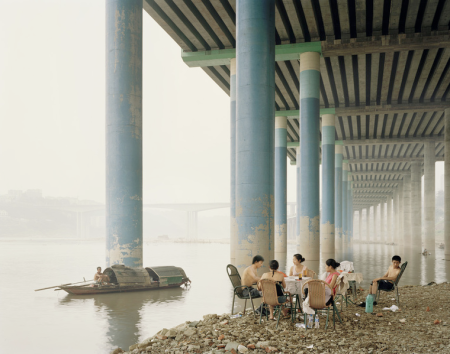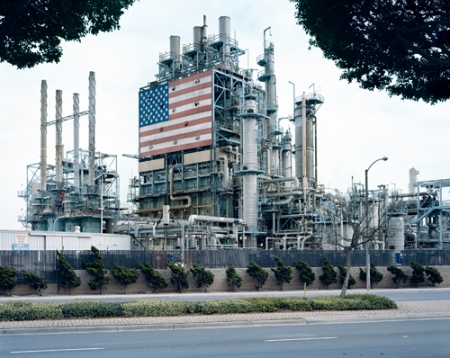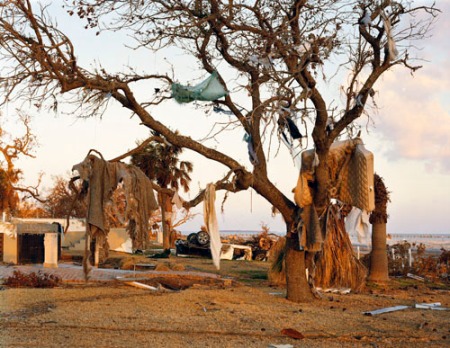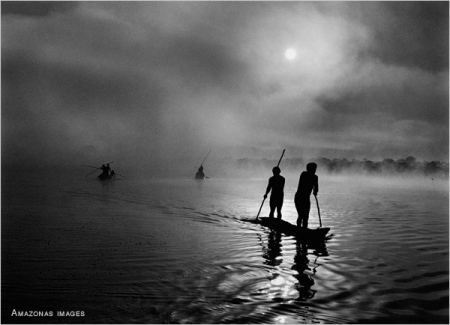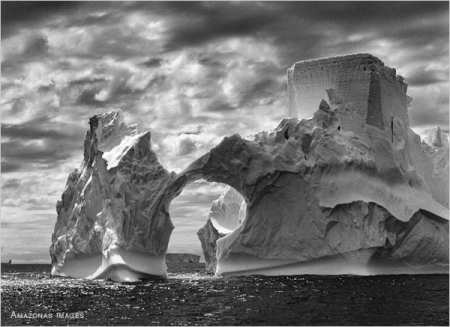Posts Tagged ‘environmental photography’
Yann Arthus-Bertrand captures fragile Earth in wide-angle
January 19, 2012ECOAESTHETIC: The Tragedy of Beauty
June 15, 2010ECOAESTHETIC is an annual summer experience of environmental issues affecting our visual world and spiritual selves through exhibitions and special events.
ECOAESTHETIC: The Tragedy of Beauty is the first exhibition of SEA to be mounted in Exit Art’s main gallery. In keeping with SEA’s mission to present artworks that address socio-environmental concerns – and to unite artists, scholars, scientists and the public in discussion on these issues –ECOAESTHETIC will establish a summer encounter of social and environmental projects. Through the work of nine international photographers, it approaches the mystery of beauty in the natural and built environment, which can be destructive or utopian.
The Tragedy of Beauty will focus on photography of land where the tragedy of the image becomes the aesthetic of the environment. The artists in this exhibition do not have a passive engagement with the environment; rather, they seek out beautiful and tragic images to emphasize the human impact on fragile ecosystems, to elucidate our relationship to nature, and to visualize the violence of natural disasters. The purpose of The Tragedy of Beauty is to demonstrate that global environmental struggles are creating an aesthetic.
In conjunction with The Tragedy of Beauty, Exit Art will also create a collective terrarium in its two ground floor windows facing 36th Street and 10th Avenue. For this project, the public has been invited to bring a plant and a photo of themselves with the plant to Exit Art, in order to contribute to a communal garden that gives a presence to the local environmental movement.
Curated by Papo Colo, Jeanette Ingberman, Lauren Rosati and Herb Tam.
ARTISTS:
Edward Burtynsky (Canada); Mitch Epstein (USA); Anthony Hamboussi (USA); Chris Jordan (USA); Christopher LaMarca (USA); Sze Tsung Leong (USA); David Maisel (USA); Susannah Sayler/The Canary Project (USA); Jo Syz (UK)
Exit Art
475 Tenth Ave
New York, NY 10018
T. 212 966 7745
F. 212 925 2928
E. info@exitart.org
Gallery Hours:
Tuesday – Thursday 10:00am – 6:00pm
Friday 10:00am – 8:00pm
Saturday 12:00pm – 8:00pm
Opening Reception: Friday June 16, 2010, 7-10 pm.
Dates of Exhibition: June 18 – August 18, 2010.
Ed Kashi: Madagascar, A Land Out of Balance
May 4, 2010Each year the Prix Pictet commissions one of its short listed photographers to produce a body of work based on a region where Pictet & Cie is supporting a sustainability program. In 2009, Ed Kashi won the honors of this commission, taking him to Madagascar in connection with a UK Charity titled Azafady helping the poorest communities in Madagascar develop sustainable ways of living. I recently visited the Diemar/Noble Gallery here in London on Well St. only a couple of days after the opening reception and general huge bash for unveiling of this series of images. As much as I love a party, it’s really difficult to see the work in its entirety at an opening, with people and drinks always in the way.
Madagascar is one of the richest nations in the world when it comes to biodiversity. Yet it is simultaneously one of the poorest, with poverty and unsustainability reeking havoc on the land and people. Ed Kashi is an award winning photojournalist well known for his work dedicated to documenting the social and political issues of our times, recently and specifically about environmental degradation as it affects the state of humanity and the world. Kashi traveled to Madagascar in January of this year to document the ongoing destruction of the forest, the increasing desertification of once lush habitat, and the plight of the people as they fall ever deeper into a state of poverty as a result of dramatic unsustainable development. The party charity organization, Azafady, is working with some of the poorest communities in developing sustainable ways of living through promoting local forest management solutions and engaging people in planning, implementation and monitoring activities, and reducing forest dependence and depletion of forest resources. Kashi writes, “This Commission for the Prix Pictet is in direct response to the global cry to stop and take responsibility, seen through the dignified and vibrant people of south east Madagascar.”
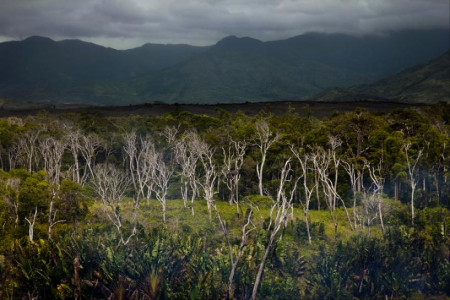
The illegal practice of tavy, or slash and burn agriculture, is one of the most urgent threats to Madagascar's people and forests. As farmers search for fertile land in which to plan their crops, the forest is destroyed and a life-saving resource for Madagascar's rural poor is lost.
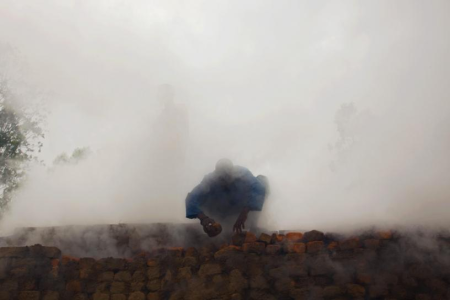
Men work on a brick kiln in Anosibe. This is a very inefficient use of wood, which is the main source of fuel for burning the clay to make the bricks.
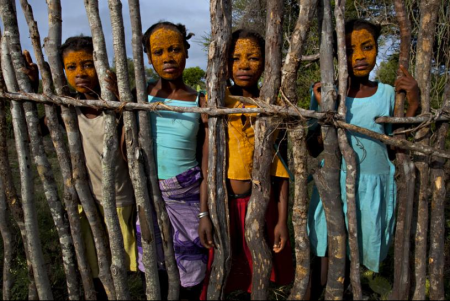
These young girls, ages 11-13, use a paste made from the tsiambara plant's roots to beautify their skin. They usually leave it on for 5 days and keep on redoing the process except on market days. The meaning of this process is called "I don't want to show you".
For further info and plenty more images, please visit Diemar/Noble, Prix Pictet, or Ed Kashi’s website’s directly.
While I realize that this specific exhibition would be documentary in nature due to both Kashi’s work and the nature of the commission, regardless of this I am still aware that there is a crossover between social documentary and fine art that’s taking place in the art world. This was a fine example. Diemar/Noble specializes in fine art photography, generally large scale in both the process and presentation, and using materials around since relatively early on in the medium’s history. I’m not saying you can’t be a fine art photographer if you don’t shoot 8×10 negatives. However, it is becoming more and more clear that the well known gap between photojournalists who are harnessing the power of images to deliver news and events of the moment (these days with 35mm digital cameras), and fine art photographers exploring abstract ideas through visual imagery using the camera as their tool (large format film), is closing. Or at least lessening in its size. This blog could sometimes be seen as an example of that. Although I set out initially to cover fine art photographers and keep the focus very much in the art world, I’m finding it hard to exclude some documentary and reportage photographers simply because of style. Surely it should be the content, intention, and success their images have on sending messages regarding the environment and related issues. But why is it then we regard photographs in a newspaper in a different light than if those same photographs were viewed in a gallery?
Context, social pretense, and the idea of the gallery or museum as the ultimate authority on art could a handful of reasons. A photograph changes from being a document to something more expressive when taken from the front page to a gallery wall. The photograph itself however doesn’t change. The technical elements of a photograph, its actual physical appearance, none of that changes. Instead, it is our interpretation of it. And yet, when I look at a photograph I usually instantly categorize it as one or the other. I am still intrinsically aware of stylistic differences in the photographer’s approach. What do you think? Do you think it’s fair that this line of separation is drawn and has been kept apart for quite some time? I welcome your thoughts in the comments section.
Nadav Kander wins the 2009 Prix Pictet Prize
October 26, 2009The Prix Pictet is an annual search for photographs that communicate powerful messages of global environmental significance under a broad theme. This year that theme was “Earth”. Nadav Kander was nominated for his series of photos, Yangtze, The Long River Series, 2006-07, documenting the rapidly changing landscape and communities of China’s Yangtze River, from its mouth to source, and this past week he was awarded the prize at FIAC in Paris, which I just happened to be leaving from that day. Sadly I missed the announcement and events that evening, but was nonetheless thrilled at the news.
Kofi Annan, the Prix Pictet’s Honorary President while also esteemed Nobel Laureate and former Secretary General of the United Nations, awarded Kander the prize saying that, “The photographs were a compelling call for action to tackle climate change, the most serious humanitarian and environmental challenge facing the world today. Only weeks separate us from the decisive negotiations on climate change in Copenhagen. We are confronted with the vital need to prepare the political momentum necessary for a fair and effective post-Kyoto agreement. The images in front of us remind us of the fragility of our planet and the damage we have already done. When we see these photographs we cannot close our eyes and remain indifferent. Through our actions and voices, we must keep building the pressure to secure urgent action at Copenhagen and beyond.”
Kander is a British based photographer, one I’ve never had the chance to work with, but have wanted to a number of times. I remember doing an interview with a big time ad agency on the west coast, and Nadav Kander was the first photographer out of my mouth when I was asked which dream photographers I’d like to worth with but haven’t had the privilege of. Kander photographed the Yangtze River from mouth to source, or over 4000 miles of watery arteries running across China. According to his artist statement, he didn’t set out with any pre-conceived notions of the river or its inhabitants– which make up more than all of the people in the entire US– but instead let the landscape do the work for him, and guide the kind of pictures he took as a physical response to the environment. What struck me the most about these images is that despite the presence of people or industry, both creators of commotion and therefore sound, the pictures felt eerily quiet. The color palette of tans and browns that make up the river and smog feel as if sound would simply not exist in that landscape. This is reinforced in the way Kander effectively portrays the sheer size of the river– which directly relates to China’s ever increasing population growth and development—using people against the backdrop of overpasses, industry, and of course water. This makes the Chinese individual seem incredibly small as opposed to the gargantuan amount and speed of development currently taking place.
While these are just four examples from this body of work, I urge you not only to explore Kander’s work further by visiting this link to his personal website, but by also reading his moving and straight to the point artist statement which can be found here.
Chris Jordan during TEDtalk
August 20, 2009From the 2008 TEDtalk, Chris Jordan explains his work and how it aims to connect our everyday actions to the unfathomable statistics we encounter on a daily basis. Approx. 11 minutes in length.
Mitch Epstein: American Power
July 21, 2009Mitch Epstein is best known for his photographs of American life. From the demise of his father’s small business, to society’s recreational idiosyncrasies, to the face of a changing New York City, Epstein delivers a style classified somewhere between conceptual and documentary, showing the ordinary in its extraordinary state. His switch from black and white to color photography in the 70s was one of the first to be accepted as “art”, and not just slick advertising, which is what color was used for before that time.
Between 2003 and 2009, Epstein photographed the United States landscape and society as it related to energy production. “Energy tourism”– Epstein called it in an artist statement. He set out to photograph fossil fuel, nuclear, as well as green energy production sights, and their affects on the people, life, and environs directly surrounding it. They raise questions not only of western culture and its respective energy use, but also of shifting and often times unbalanced states of power– the power of nature vs. electrical power vs. political power vs. America’s power in terms of the global perspective.
Epstein visited 25 states over the past 6 years shooting nuclear power plants, wind farms, coal plants, and the Americans who live with them in their very own backyards. He did, however, encounter several setbacks. First was Hurricane Katrina in 2005, which affected 30% of land in the US used for oil production. More oil refineries line the Gulf Coast than anywhere else in the country. Epstein shifted gears for this area turning his focus from oil production to the coast’s vulnerability in future natural disasters.
For more images and information on American Power and other photographic projects by Mitch Epstein, please visit his website or NYC gallery.
American Power is available for pre-order on Amazon by clicking on the book.
Sebastião Salgado: Genesis
July 3, 2009Sebastiao Salgado one of the most well known photo journalists of our time. Over the past 36 years the Brazilian born photographer has been photographing developing countries and their respective communities showing us what these remote locations, their peoples, and their everyday lives entail. Salgado works in the humanitarian and social documentary vein, seeking out indigenous cultures as well as impoverished ones, with previous projects including migrant workers, displaced peoples, famine and war torn lands, and political issues. He uses photography as a means to the end, utilizing its immediate visual story telling capabilities as a tool to further urgent political and social issue based discussion.
Salgado began his career as a professional photographer in Paris, in 1973, and worked with the photo agencies Sygma, Gamma, and Magnum Photos up till 1994, when he and Lélia Wanick Salgado created Amazonas images, an agency that exclusively handles his work. Together, Lélia and Sebastião have worked since the 1990’s on the restoration of a small part of the Atlantic Forest in Brazil. In 1998 they succeeded in making this land a nature preserve and created Instituto Terra, whose mission is reforestation, conservation and environmental education.
Salgado’s latest and probably the largest project to date is titled Genesis (which he says was not meant to invoke religious connotation), an environmental documentary project on a grandiose scale. While previously photographing the plight of various lands and its peoples, Salgado, an environmentalist, thought he needed to photograph the areas that have not been touched by humans, war, famine, pestilence, etc. To show the amazing and precious places that still exist on this planet is to bring to light how important and urgent their survival and preservation is. He hopes to make a difference in the larger environmental movement through his images of “pristine” places around the globe, taking him from 3 months in the Galapagos, to 500 miles trekking across the Ethiopian mountains. He has turned to focus from social systems to eco systems.
The images are dark and moody, in a grainy black and white. And while I’ve learned that Salgado has recently switched to digital cameras, the images still appear consistent with his style and look for over the past 30 years. They are not to be confused with traditional journalistic imagery, as he subjects here aren’t seen from a voyeurs point of view. Instead Salgado engages with his subjects, be it African tribesmen, Russian bears, or Venezuelan forests. They are slightly romanticized, but not overly so. I think the aim for this project is to romanticize these places specifically for the purpose of showing viewers eco systems that yet remained untouched, but only for so much longer. They have to be shown in an elevated light in order to truly cause emotion and not just give information.
Salgado’s work is all about context. Nothing is static or still, even in an image that may appear still. The narrative present has a past and a future, we’re only glimpsing a moment in passing. There is a real sense of fluidity in his images, but a calculated fluidity as well. Technically, they are perfect. Composition, light, POV, angles, all come together in the frame. But, that is the means to an end as well. There is always a story behind each Salgado photograph, and his techniques are merely the language with which he tells these stories. The style or genre is not quite documentary, not quite fine art, but somewhere again, in flux, moving between the two never landing in one place or the other, just like his images.
Salgado says of this body of work, “I have named this project GENESIS because my aim is to return to the beginnings of our planet: to the air, water and the fire that gave birth to life, to the animal species that have resisted domestication, to the remote tribes whose ‘primitive’ way of life is still untouched, to the existing examples of the earliest forms of human settlement and organisation. A potential path towards humanity’s rediscovery of itself. So many times I’ve photographed stories that show the degradation of the planet, I thought the only way to give us an incentive, to bring hope, is to show the pictures of the pristine planet – to see the innocence. And then we can understand what we must preserve.” -Sebastião Salgado via Jori Finkel for the NY Times.
To see more of Salgado’s striking images on what looks to be a 12 years project, currently 4 already under his belt, please visit the Peter Fetterman gallery where he is represented by clicking here.
Further links to the NY Times article here and to the Guardian’s regular posts on Genesis as it progresses here.
Questions and Answers: Richard Misrach
June 12, 2009“In preparation for the High’s installation of On the Beach, Richard Misrach took time to answer a few questions about his influences and experiences over the course of his career” for his new solo exhibition titled “On the Beach” recently opened at the High Museum in Atlanta. The following is the full Q+A courtesy of the museum.
1. Your photographs often draw attention to human impact on the environment. Why is this issue important to you? Do you have a positive or negative view of the direction in which we are moving, given all that you have seen?
It is the great paradox of human existence. We must exploit our environment to exist, and we risk destroying it (and ourselves) in the process. It’s an extraordinary delicate balance and a compelling subject for one’s life’s work.
But there is also a deeply personal element to the work because I love being in the landscape: I find an aesthetic pleasure there that I don’t quite understand. My pictures are as much, maybe more, about the existential mystery of what I experience in the landscape than about civilization’s relation to it.
As far as the future of the planet, it’s hard not to worry. Just because we haven’t set in motion an irreparable calamity yet, is no insurance that we won’t in the future. Our nuclear arsenals, overpopulation, energy challenges and pollution remain growing threats. And yet, more than likely, it will be the unexpected that will be our undoing.
2. You have typically focused on the American landscape, free of human figures. In On the Beach, figures populate many of the scenes—why? What brought about this change?
After 9/11 several images of people falling/jumping from the towers were published in newspapers. Those images were some of the most terrifying and heartbreaking I’ve ever seen. I was haunted by them.
In the past, I photographed people in the landscape where they usually introduced a sense of scale and relationship to our manmade environment. The people falling from the towers provided a whole new kind of scale: a relationship to the abyss—the abyss that haunts all of us. Because of those pictures, I found traces of our relationship to the sublime—fear, resilience, defiance, peace and joy—even in the most ordinary activities by the sea.
3. You’ve been asked a lot about how you made the photos. What inspired you to assume that particular vantage point? How does it enhance the images and/or the message behind them?
The unusual “god’s eye view” draws attention to itself implicating the photographer in the process. This was important to me, as I was struck by the fact that right after 9/11, people carried on with their lives as if nothing had happened. People were vacationing and I was working; it was really weird actually.
It reminded me of that great Bruegel painting of Icarus falling into the sea. As Icarus plunges to his death, the farmer tills, the ship sails, life goes on.
My photograph of the handstand evokes the painting while inverting it—the legs represent the resilience? Obliviousness? In the face of our national tragedy. Even at the moment of such a profound national tragedy life inexplicably goes on.
Also, there is a sense of voyeurism and surveillance embedded in the all seeing vantage point. It is a relatively benign reminder—nobody is really compromised—but the camera is always watching in our Google satellite world.
4. To create the On the Beach series you used an 8×10 view camera. Can you talk a little about the technical advantages and challenges of working with a large format camera?
From a technical standpoint the 8×10″ camera was the wrong tool for this project. It is a cumbersome suitcase that requires reloading for each shot and has slow shutter speeds. It is not good for quick captures or stopping movement. By the time I would set up the camera, focus, load the film holder, pull out the film slide and depress the shutter, my subjects had often literally swum out of the frame. So many great pictures were missed.
That said, the fine detail afforded by the large negative, when I did get what I wanted, was crucial to achieve the intimate gestures and grand scale of the work.
5. You are perhaps best known for your images of the American West. What drew you to that landscape? How do you choose a location?
I was born in Los Angeles and surfed and skied growing up. The western landscape was my universe. Since 1968 I have had five Volkswagon campers which I’ve used to travel the West for 2 to 3 weeks at a time. I throw in my camera, food, film and some coolers with film holders, and head off without any destination in mind.
If it’s hot, I stay north, cold, I head to southern deserts. Basically, I wander around chasing the light from dawn to dusk and see what I can discover.
I usually found that if I had a preconceived idea for a project it wouldn’t amount to much. Discovery—an aggressive receptivity, if you will—of what is in the landscape provides the inspiration for new ideas.
6. With the advent of digital technology, photography has consolidated its position as the medium of the masses…what are your views on the prevalence of photography on the internet and the use of digital? How has it impacted your work?
So far the omnipresence of imagery on the internet hasn’t had a huge impact on me. However, digital production has completely changed the way I work and think about photography. I haven’t shot film in almost two years and am now making all of my own prints again (haven’t done that since the 1970’s). Some prints are as large as 10×13 feet!
Having full access to the new technologies has encouraged me to play and experiment in ways that take me back to when I was a beginning photographer. And given that everyone now in college will have the same opportunities—access to the means of production and radical new tools—the medium is destined for big, important changes. I can’t imagine a more exciting period for photography.
7. Over the course of your career photography’s place in the world of fine art has shifted and evolved. Do you feel that the way that photography is perceived/accepted has changed significantly since you began?
Despite historic claims to the contrary, photography was marginalized by the art world for a long time. However, in the last decade and a half, photography has been at the fore of art world practice. Moreover, when I began photography the idea of making a living selling work in galleries wasn’t even a fantasy. Now, for better or worse, photography has entered the art marketplace big time.
8. How did you break into photography and what advice would you give to aspiring photographers?
I think it was in 1968 that I saw the work of a young photographer, Roger Minick, hung on a wall in a small gallery at UC Berkeley where I was a student. I was deeply moved by the content of the work and the beauty of the prints, and I knew immediately that was what I was supposed to be doing with my life. I had never felt that before. Advice to aspiring photographers—follow your passion and work hard. If you are worried about career or marketplace, find another line of work…
Thanks to the museum for providing the Q+A. And if you’d like detailed exhibition information, Misrach’s bio, or to listen to the podcast lecture given by Richard on this body of work, please visit the museum’s website section devoted to this exemplary body of work by clicking here.



